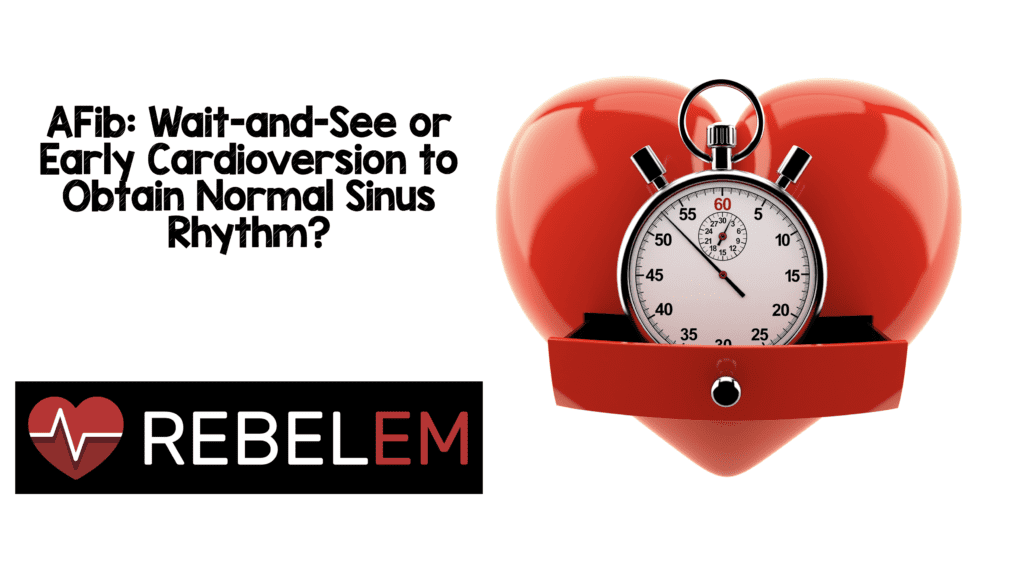
What They Did:
- RACE 7 ACWAS (Rate Control versus Electrical Cardioversion Trial 7 – Acute Cardioversion versus Wait and See)
- Determine if a delayed cardioversion, or Wait-and-See (WAS) approach to hemodynamically stable, recent onset (<36hrs) AF in the ED has similar rates of conversion to sinus rhythm as early cardioversion at 4 weeks post-ED visit
- Multi-center, randomized, non-inferiority trial, in 15 hospitals in the Netherlands
- Patients randomized 1:1 ratio to either:
- Early pharmacologic cardioversion, preferably with flecainide. Patients who failed pharmacologic cardioversion, those with contraindications to pharmacologic cardioversion, or history of previous unsuccessful pharmacologic cardioversion underwent electrical cardioversion
- Delayed cardioversion (WAS):
- Rate control to <110 bpm using IV or oral B-Blockers, non-dihydropiridine calcium channel blockers (diltiazem or verapamil), or digoxin
- Patients discharged home if clinically stable with outpatient clinic visit and 12 lead ECG the next day (within 48 hrs of symptom onset)
- Patients with persistent AF at next-day follow-up were referred to ED for delayed cardioversion
- Patients at high risk for stroke and not on previous anticoagulation were started on anticoagulants before or immediately after cardioversion
- All patients had a 4-week follow-up visit and 12 lead ECG to assess for presence or absence of AF
Outcomes:
- Primary: presence of sinus rhythm on ECG at the 4-week follow-up visit
- Secondary:
- Duration of initial visit at the ED
- ED visits related to AF
- Cardiovascular complications, defined as events leading to an ED visit or hospital admission including
- heart failure
- ischemic stroke
- TIA
- unstable angina or ACS
- symptomatic bradycardia or tachycardia
- hypotension
- Time until recurrence of AF, as determined via use of ECG telemetry device (MyDiagnostick, Applied Biomedical Systems) three times daily or in case of symptoms, until the 4-week visit
- Patients’ quality of life using the Atrial Fibrillation Effect on Quality-of-Life questionnaire (AFEQT), with scores ranging from 0 to 100 and higher scores indicating a better quality of life
Inclusion:
- Hemodynamically stable adults > 18 years old with AF on ECG at a ventricular rate >70 bpm, for a duration <36 hours prior to presentation.
Exclusion:
- Hemodynamic instability
- Signs of MI on ECG
- Presence of pre-excitation syndrome
- History of Sick Sinus Syndrome
- History of unexplained syncope
- History of persistent AF (AF lasting >48 hrs)
- Acute heart failure
- Other (as deemed unsuitable by attending physician)
Results:
- 437 patients randomized, 10 were lost to follow-up or withdrew consent
- No significant difference in patient characteristics between the 2 groups at baseline
- Primary Outcome: Presence of NSR at 4 weeks
- Delayed Cardioversion: 193/212 (91%)
- Early-Cardioversion:202/215 (94%)
- 95% CI -8.2 – 2.2; p = 0.005 for non-inferiority
- In the Delayed Cardioversion Group:
- 150 (69%) were spontaneously in NSR at 48hrs
- 61 (28%) required delayed chemical or electrical cardioversion
- Rate control medication given in 175 patients in the ED
- Metoprolol: 82.9%
- Other Beta Blocker: 5.7%
- Verapamil: 2.9%
- Median duration of initial ED visit: 120 minutes
- In the Early Cardioversion Group:
- 36 (16%) were spontaneously in NSR at 48hrs
- 171 (78%) required early chemical or electrical cardioversion
- Median duration of initial ED visit 158 minutes
- Telemetric ECG recordings were available for 335 patients. Recurrence of AF occurred in
- 49/164 patients in WAS group (30%); median time 12 days
- 50/171 patients in early cardioversion group (29%); median time 8 days
- There was no significant difference in the other secondary outcomes of cardiovascular complication rates, number of ED visits for AF, or mean AFEQT global scores between the 2 groups.
Strengths:
- Randomized, multi-center trial
- Emergency Department-based study
- Variety of hospitals, including academic, non-academic teaching, and nonteaching facilities
- Study cohort enrolled over a 4 year period
- Simple well-executed study design
- Meaningful, relevant, easy to measure endpoints
- Boehringer Ingelheim provided some devices for remote monitoring of patients by ECG but had no role in the study design, execution of the trial, management of the data, or statistical analyses
- Transesophageal echocardiography was not required nor performed in any patient as this may not be feasible at every institution
- All ECGs were assessed for the presence of sinus rhythm by the first two authors of the paper
Limitations:
- As the authors themselves mention, the study is not powered sufficiently to assess for safety.
- Cardiac monitoring was not provided to 102 patients because of lack of availability
- Since cardiac monitoring was done intermittently, the true rate of AF recurrence over 4 weeks may be higher for patients in both groups than collected and reported in the data.
- Patients and attending physicians were aware of the trial-group assignments which may introduce bias
- Outpatient clinic visits were planned for the next day, as close as possible to 48hrs after onset of symptoms which may not be generalizable to every institution
Discussion:
This study supports previously known information and numbers regarding spontaneous conversion rates of AF to sinus rhythm. Unfortunately, it is difficult to predict which individual patients will convert to sinus rhythm spontaneously. Reasons to pursue a rate-control strategy over rhythm control in the in the ED for the hemodynamically stable AF patient include avoiding complications of pharmaceutical cardioversion, avoiding need for sedation in electrical cardioversion, and decreased ED length of stay, particularly in light of the fact that the rate of spontaneous conversion to NSR has been reported up to 70%. Patients in this Dutch study had access to close follow-up and reassessment within a day of their initial ED visit. This could prove to be a significant challenge and limiting step for many patients and providers in the U.S. In order to adopt this strategy, the ED provider would need to very carefully select a subset of patients who have been in AF for <36 hours and schedule a repeat visit within 48 hours of symptom onset to allow for cardioversion, if necessary. This would likely represent a small number of patients that would be eligible for this strategy.
Current guidelines recommend the use of anticoagulation in patients with a CHA2DS2-VASc score >2 in men or > 3 in women. (6) Pursuing a delayed cardioversion strategy on an outpatient basis for patients with AF in the ED at high risk for stroke would require calculation of the CHA2DS2-VASc score, discussion and initiation of anticoagulation prior to discharge home, to not only prevent stroke but in anticipation of possible delayed cardioversion. In this particular study 60 patients in the delayed conversion group were started on anticoagulants during the initial visit, the vast majority being direct oral anticoagulants (DOACs). 90 patients in the delayed cardioversion group were already on some form of anticoagulation prior to their initial ED visit. With the recent update in guidelines to include DOACs for patients with AF, this strategy is made potentially easier. (6)
Of the delayed conversion group, 125 patients had a history of recurrent AF while 120 of the early conversion group had a similar history. None had episodes lasting >48 hours. This means >50% of the patients in the study had a previous history of AF that terminated within 48 hours. Is a patient with a past history of spontaneously converting AF more likely to spontaneously convert to sinus rhythm again? If so, this would introduce an element of selection bias into the study and potentially inflate the rates of spontaneous conversion.
The long-term efficacy, safety, and cost-effectiveness of a wait-and-see approach compared to immediate cardioversion is still unknown. Fortunately, these are just the initial results of what is to be an eventual year-long study.
Author Conclusion: “In patients presenting to the emergency department with recent-onset, symptomatic atrial fibrillation, a wait-and-see approach was noninferior to early cardioversion in achieving a return to sinus rhythm at 4 weeks.”
Clinical Take Home Point:
Most patients with AF will convert spontaneously to sinus rhythm and, in the absence of hemodynamic compromise, there is no need to rush for rhythm control in the ED. It is difficult to predict which specific patients will convert spontaneously and over what period of time. Providers need to assess severity and duration of symptoms, access to follow-up, risks for CVA, and available anticoagulation strategies, amongst other factors, in the management of patients with AF. Based on this study, a delayed conversion strategy for a specific group of AF patients demonstrates similar rates of sinus rhythm at 4 weeks with no difference in potential risks or patient-reported quality of life as compared to an early cardioversion strategy.
References:
- January CT et al. 2014 AHA/ACC/HRS Guideline for the Management of Patients with Atrial Fibrillation: A Report of the American College of Cardiology/American Heart Association Task Force on Practice Guidelines and the Heart Rhythm Society. Circulation 2014. PMID: 24682348
- Olshansky B et al. The Atrial Fibrillation Follow-up Investigation of Rhythm Management (AFFIRM) study: approaches to control rate in atrial fibrillation. J Am Coll Cardiol 2004. PMID: 15063430
- Van Gelder IC et al. A comparison of rate control and rhythm control in patients with recurrent persistent atrial fibrillation. N Engl J Med 2002. PMID: 12466507
- Hagens VE et al. Effect of rate or rhythm control on quality of life in persistent atrial fibrillation: results from the Rate Control Versus Electrical Cardioversion (RACE) Study. J Am Coll Cardiol 2004. PMID: 14736444
- Pluymaekers NAHA et al. Early or Delayed Cardioversion in Recent-Onset Atrial Fibrillation. N Engl J Med. 2019. PMID: 30883054
- January CT et al. 2019 AHA/ACC/HRS Focused Update of the 2014 AHA/ACC/HRS Guideline for the Management of Patients With Atrial Fibrillation: A Report of the American College of Cardiology/American Heart Association Task Force on Clinical Practice Guidelines and the Heart Rhythm Society. Heart Rhythm. 2019. PMID: 30703530
For More Thoughts on This Topic Checkout:
- EM Nerd (EMCrit): The Case of the Irregular Irregularity Continues
- St. Emlyn’s Blog: Should we Rapidly Cardiovert AF in the ED?
- The Breach: Should we Cardiovert Everyone with Recent-Onset Fast AF?
- The SGEM: SGEM #260 – Quit Playing Game With my Heart – Early or Delayed Cardioversion for Recent Onset Atrial Fibrillation?
Post Peer Reviewed By: Salim R. Rezaie, MD (Twitter: @srrezaie)



